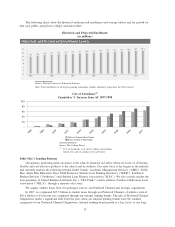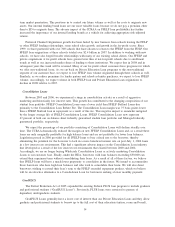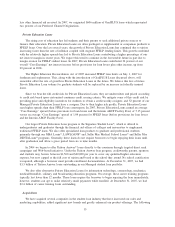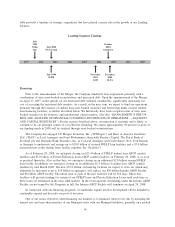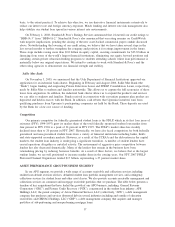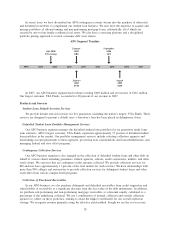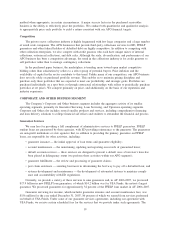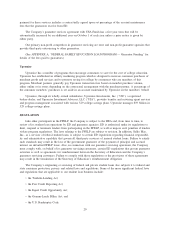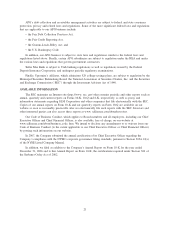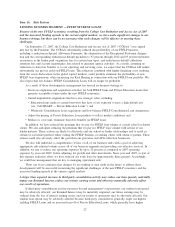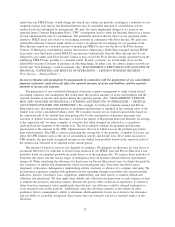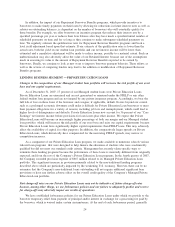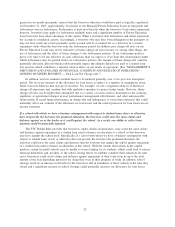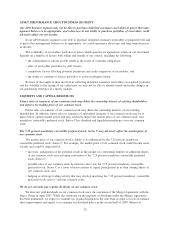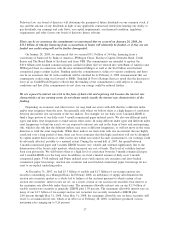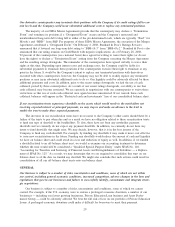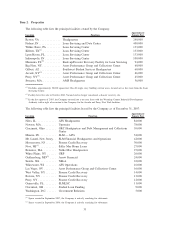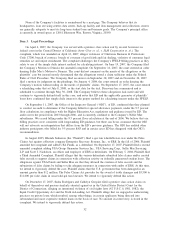Sallie Mae 2007 Annual Report Download - page 24
Download and view the complete annual report
Please find page 24 of the 2007 Sallie Mae annual report below. You can navigate through the pages in the report by either clicking on the pages listed below, or by using the keyword search tool below to find specific information within the annual report.yields than our FFELP loans, would change the overall mix within our portfolio resulting in a reduction to our
weighted-average loan spread. Our Retained Interest may be materially impaired if consolidation activity
reaches levels not anticipated by management. We may also incur impairment charges if we increase our
expected future Constant Prepayment Rate (“CPR”) assumptions used to value the Residual Interest as a result
of such unanticipated levels of consolidation. The potentially material adverse affect on our operating results
related to FFELP loans also relates to our hedging activities in connection with Floor Income. We enter into
certain Floor Income Contracts under which we receive an upfront fee in exchange for our payment of the
Floor Income earned on a notional amount of underlying FFELP Loans over the life of the Floor Income
Contract. If third-party consolidation activity that involves refinancing a Sallie Mae managed existing FFELP
Loan with a new third-party owned FFELP Loan increases substantially, then the Floor Income that we are
obligated to pay under such Floor Income Contracts may exceed the Floor Income actually generated from the
underlying FFELP loans, possibly to a material extent. In such a scenario, we would either close out the
related Floor Income Contracts or purchase an offsetting hedge. In either case, the adverse impact on both our
GAAP and “Core Earnings” could be material. (See “MANAGEMENT’S DISCUSSION AND ANALYSIS OF
FINANCIAL CONDITION AND RESULTS OF OPERATIONS — LENDING BUSINESS SEGMENT —
Floor Income — Managed Basis.”)
Incorrect estimates and assumptions by management in connection with the preparation of our consolidated
financial statements could adversely affect the reported amounts of assets and liabilities and the reported
amounts of income and expenses.
The preparation of our consolidated financial statements requires management to make certain critical
accounting estimates and assumptions that could affect the reported amounts of assets and liabilities and the
reported amounts of income and expense during the reporting periods. (See “MANAGEMENT’S DISCUS-
SION AND ANALYSIS OF FINANCIAL CONDITION AND RESULTS OF OPERATIONS — CRITICAL
ACCOUNTING POLICIES AND ESTIMATES.”) For example, for both our federally insured and Private
Education Loans, the unamortized portion of premiums and discounts is included in the carrying value of the
student loan on the consolidated balance sheet. We recognize income on our student loan portfolio based on
the expected yield of the student loan after giving effect to the amortization of purchase premiums and
accretion of student loan income discounts, as well as the impact of Repayment Borrower Benefits. In arriving
at the expected yield, we make a number of estimates that when changed are reflected as a cumulative
catch-up from the inception of the student loan. The most sensitive estimate for premium and discount
amortization is the estimate of the CPR, which measures the rate at which loans in the portfolio pay before
their stated maturity. The CPR is used in calculating the average life of the portfolio. A number of factors can
affect the CPR estimate such as the rate of consolidation activity and default rates. If we make an incorrect
CPR estimate, the previously recognized income on our student loan portfolio based on the expected yield of
the student loan will need to be adjusted in the current period.
The amount of loan loss reserves also depends on estimates. We maintain an allowance for loan losses at
an amount believed to be sufficient to absorb losses incurred in our FFELP loan and Private Education Loan
portfolios based on estimated probable net credit losses as of the reporting date. We analyze those portfolios to
determine the effects that the various stages of delinquency have on borrower default behavior and ultimate
charge-off. When calculating the allowance for loan losses on Private Education Loans, we divide the portfolio
into categories of similar risk characteristics based on loan program type, loan status (in-school, grace,
repayment, forbearance, delinquency), underwriting criteria, existence or absence of a cosigner, and aging. We
use historical experience coupled with qualitative factors regarding changes in portfolio mix, macroeconomic
indicators, policies, procedures, laws, regulations, underwriting, and other factors to estimate default and
collection rate projections. We then apply these default and collection rate projections to each category of loan
to estimate the necessary allowance balance. Because the process relies on historical experience, if current or
future loan loss experience varies significantly from the past, our allowance could be deemed inadequate to
cover incurred losses in the portfolio. Additionally, since the allowance estimate is also reliant on other
qualitative factors, management’s ability to determine which qualitative factors are relevant to the allowance
and our ability to accurately incorporate these factors into our estimates can have a material impact on the
allowance.
23


